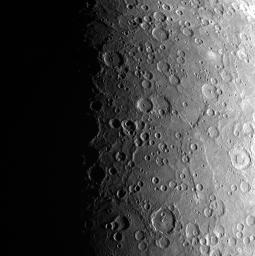
|
Hasta La Vista, Baby!
- Click the image above for a larger view
- Full-Res JPEG (1020 x 1024) (167.0 kB)
- Full-Res TIFF (1020 x 1024) (1.0 MB)
Caption:
This striking image shows the progression of daylight across the surface of Mercury. This line separating night from day is called the terminator . Scientists have studied interesting phenomena occurring near the terminator of the Moon for years. Such occurrences involve the interaction between lunar dust and charged solar particles. Because Mercury's regolith is exposed to almost ten times as many charged particles as the Moon, it is an excellent place to study the effects of solar radiation on surface materials. In this unprojected image, north is to the right.
This image was acquired as part of MDIS's campaign to monitor the south polar region of Mercury. By imaging the polar region approximately every four MESSENGER orbits as illumination conditions change, features that were in shadow on earlier orbits can be discerned and any permanently shadowed areas can be identified after repeated imaging over one solar day. During MESSENGER's one-year primary mission, MDIS's WAC was used to monitor the south polar region for the first Mercury solar day (176 Earth days), and MDIS's NAC made repeated images of the south polar region during the second Mercury solar day.
Date acquired:
August 01, 2011
Image Mission Elapsed Time (MET):
220726567
Image ID:
579208
Instrument:
Wide Angle Camera (WAC) of the Mercury Dual Imaging System (MDIS)
WAC filter:
7 (748 nanometers)
Center Latitude:
-84.97°
Center Longitude:
75.81° E
Resolution:
1500 meters/pixel
Scale:
The large crater at the bottom center is 155 km (96 mi) in diameter.
Incidence Angle:
84.9°
Emission Angle:
23.8°
Phase Angle:
97.0°
Background Info:
The MESSENGER spacecraft is the first ever to orbit the planet Mercury, and the spacecraft's seven scientific instruments and radio science investigation are unraveling the history and evolution of the Solar System's innermost planet. Visit the Why Mercury? section of this website to learn more about the key science questions that the MESSENGER mission is addressing. During the one-year primary mission, MDIS acquired 88,746 images and extensive other data sets. MESSENGER is now in a year-long extended mission, during which plans call for the acquisition of more than 80,000 additional images to support MESSENGER's science goals.
These images are from MESSENGER, a NASA Discovery mission to conduct the first orbital study of the innermost planet, Mercury. For information regarding the use of images, see the MESSENGER image use policy .
Cataloging Keywords:
| Name | Value | Additional Values |
|---|---|---|
| Target | Mercury | |
| System | ||
| Target Type | Planet | |
| Mission | MESSENGER | |
| Instrument Host | MESSENGER | |
| Host Type | Orbiter | |
| Instrument | Mercury Dual Imaging System (MDIS) | |
| Detector | Wide Angle Camera (WAC) | |
| Extra Keywords | Crater, Dust, Grayscale, Moon, Radio, Shadow | |
| Acquisition Date | ||
| Release Date | 2012-07-17 | |
| Date in Caption | 2011-08-01 | |
| Image Credit | NASA/Johns Hopkins University Applied Physics Laboratory/Carnegie Institution of Washington | |
| Source | photojournal.jpl.nasa.gov/catalog/PIA16360 | |
| Identifier | PIA16360 | |
